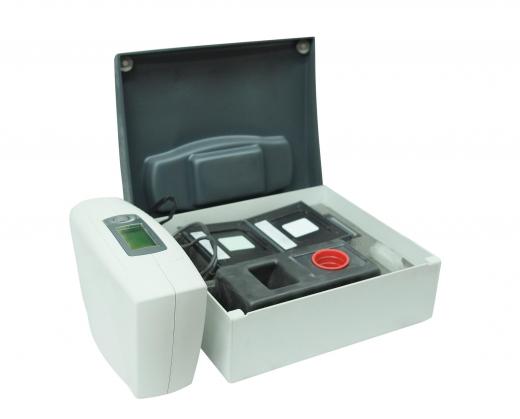What Is Colorimetry?
 Mary McMahon
Mary McMahon
Colorimetry is the analysis of chemical samples to collect information about their concentration. It involves passing light through a sample and measuring how much is absorbed by the solution, using equipment like a spectrophotometer to measure as precisely as possible. The technique may be one of several tests performed on a sample to determine its composition, check for quality and clarity, or demonstrate scientific principles in a classroom. Manufacturers of scientific instruments produce a range of instruments for this purpose.
Before a sample can be tested, the equipment needs to be calibrated to make sure it is working properly. A chemist may start with a clear solution to check for stray light and other problems. Vials containing a solution of known composition and concentration can also be used as a baseline or reference sample. These allow technicians to check the equipment and make any necessary adjustments before they start working with an unknown or questioned sample, to confirm that the measurements will be accurate.

To set up for colorimetry measurements, the technician mounts the vial or beaker in a holding clip and passes light through it. A filter must be used on the light to select the appropriate wavelength for the given solution, based on color. The equipment measures the amount of light absorbed, providing information about the concentration of the solution. This can be charted on a graph, and a number of formulas can be used in colorimetry to turn the data into a meaningful measurement.

Samples may behave unpredictably. They need to be well mixed to ensure the solution is evenly distributed, or the light absorption may not be even. In addition, some may have particles of material that interfere with the movement of light through the sample, in which case the measurement may be off as well. Technicians can carefully inspect an unknown sample before testing to determine if it will behave consistently in colorimetry testing.

This term can also be used to describe the science of human color perception. In this form of colorimetry, researchers examine how people perceive color and distinguish between colors. This is important for activities ranging from designing monitors with appropriate resolution to learning about how colorblind people perceive the world around them. A variety of equipment can be used to measure color intensity and distribution to determine how people may interact with an environment or work of art like a painting or photograph.
AS FEATURED ON:
AS FEATURED ON:













Discussion Comments
@clintflint - It sounds like they use pretty sophisticated equipment in order to do this test on liquids and they've probably done it so much over the decades that there is a large database with a lot of information on how light reacts to different kinds of particles.
Light isn't just a beam of white, when it gets separated into different wavelengths it can be quite complex, so I'm sure they can tell quite a lot about a liquid this way.
Most importantly, they can get information without changing the sample, since if they dried it out and used other methods, they might change what the sample contains (for example, they might kill any living creatures in the sample).
It actually sounds like it would be quite interesting to me, although I guess if you were doing it routinely it probably wouldn't be.
This just doesn't seem like it would work well enough of the time to bother. I mean, it seems like if you have a random sample of, say, pond water, you'd almost need to already know what was in it for this kind of measurement to mean anything, because there are thousands of different kinds of particles that might be in it. I feel like the best you could do was tell how much, rather than what kinds of particles are suspended and surely there are easier ways of doing that.
This seems like a kind of foggy science to me.
Post your comments